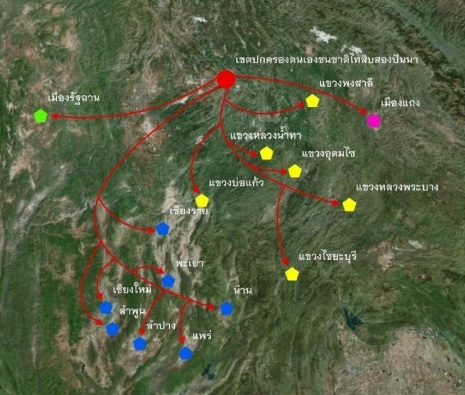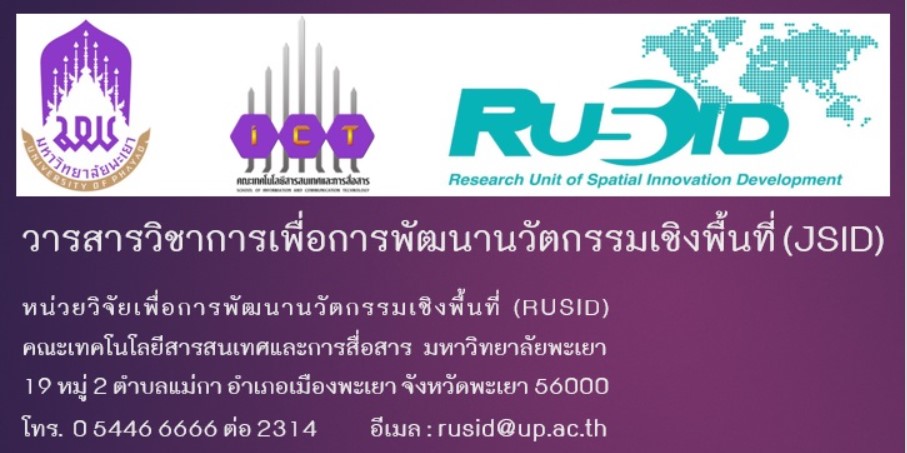เส้นทางการเดินทางและการตั้งถิ่นฐานของชาติพันธุ์ไทลื้อ กรณีศึกษา อำเภอเชียงคำ จังหวัดพะเยา
คำสำคัญ:
เส้นทางการเดินทาง / การตั้งถิ่นฐาน / ชาติพันธุ์ไทลื้อบทคัดย่อ
การศึกษางานวิจัยเรื่องเส้นทางการเดินทางและการตั้งถิ่นฐานของชาวไทลื้อ ในอำเภอเชียงคำจังหวัดพะเยา มีวัตถุประสงค์เพื่อ (1) ศึกษาเส้นทางการอพยพย้ายถิ่นฐานของกลุ่มชาติพันธุ์ไทลื้อ (2) ศึกษารูปแบบการตั้งถิ่นฐานและการกระจายตัวของกลุ่มชาติพันธุ์ไทลื้อ และ (3) ศึกษาปัจจัยที่มีอิทธิพลต่อการเลือกที่ตั้งถิ่นฐานของชาติพันธุ์ไทลื้อ ซึ่งเป็นการวิจัยเชิงคุณภาพโดยการศึกษาเอกสาร งานวิจัย และสำรวจภาคสนามบริเวณหมู่บ้านไทลื้ออำเภอเชียงคำ จังหวัดพะเยา ประกอบกับการใช้วิธีการสัมภาษณ์เชิงลึกและการเก็บแบบสอบถาม โดยผู้ให้ข้อมูลหลัก คือ ชาวไทลื้อโดยมีกลุ่มประชากรตัวอย่างทั้งหมด 60 คน ที่มีมีอายุตั้งแต่ 60 ปีขึ้นไป
ผลการวิจัยพบว่า ชาวไทลื้อเดิมตั้งถิ่นฐานอยู่สิบสองปันนา มณฑลยูนนาน สาธารณรัฐประชาชนจีน ซึ่งต่อมาชาวไทลื้อได้มีการอพยพเข้ามาอาศัยอยู่ตามหัวเมืองต่าง ๆ ของอาณาจักรล้านนา เนื่องจากภาวะสงคราม ชาวไทลื้อถูกกวาดต้อนลงมายังหัวเมืองต่าง ๆ ของภาคเหนือจากเจ้าผู้ครองนครน่าน ชุมชนไทลื้อนิยมตั้งถิ่นฐานบ้านเรือนอยู่ตามบริเวณที่ราบลุ่มแม่น้ำและที่ราบระหว่างหุบเขาที่มีแม่น้ำไหลผ่าน เส้นทางการอพยพย้ายถิ่นฐานของชาวไทลื้อ มีด้วยกันทั้งหมด 4 สาย ได้แก่ สายที่ 1 อพยพย้ายถิ่นเข้าสู่ประเทศเมียนมา สายที่ 2 อพยพย้ายถิ่นเข้าสู่ประเทศเวียดนาม สายที่ 3 อพยพย้ายถิ่นเข้าสู่ประเทศลาว และสุดท้ายสายที่ 4 อพยพย้ายถิ่นเข้าสู่ประเทศไทย ส่วนรูปแบบการตั้งถิ่นฐานของกลุ่มชาติพันธุ์ไทลื้อที่พบในอำเภอเชียงคำ จังหวัดพะเยา มี 2 รูปแบบ คือ การตั้งถิ่นฐานแนวยาว(Linear Village) ได้แก่ ตำบลเชียงบาน ตำบลหย่วน ตำบลฝายกวาง ตำบลแม่ลาว และ การตั้งถิ่นฐานแบบกลุ่ม(Cluster Village) ได้แก่ ตำบลเวียง ตำบลน้ำแวน ตำบลเจดีย์คำ ส่วนปัจจัยที่มีอิทธิพลต่อการตั้งถิ่นฐาน แบ่งได้ 2 ปัจจัย ได้แก่ ปัจจัยทางด้านแรงผลักดันและปัจจัยทางด้านแรงดึงดูด โดยแต่ละด้านจะแบ่งปัจจัยออกเป็น 4 ด้าน ได้แก่ ปัจจัยทางด้านกายภาพ ปัจจัยทางสังคมและวัฒนธรรม ปัจจัยทางด้านการเมืองการปกครอง และปัจจัยทางด้านเศรษฐกิจ ซึ่งผลได้มาจากการสัมภาษณ์และแบบสอบถาม พบว่าปัจจัยด้านแรงผลักดันที่มีอันดับสูงเป็นอันดับแรก ได้แก่ ปัจจัยด้านการเกิดสงคราม คิดเป็นร้อยละ 93.33 รองลงมาได้แก่ ปัจจัยด้านการเกิดการรุกรานของกลุ่มทางการเมือง คิดเป็นร้อยละ 93.33 และปัจจัยด้านกายภาพการขาดแคลนที่ดินทำกิน คิดเป็นร้อยละ 88.33 และปัจจัยด้านการขาดแคลนทรัพยากร คิดเป็นร้อยละ 86.67 ตามลำดับ ส่วนปัจจัยด้านแรงดึงดูดที่อันดับสูงเป็นอันดับแรก ได้แก่ ปัจจัยด้านกายภาพที่มีทรัพยากรที่สมบูรณ์ คิดเป็นร้อยละ 98.33 รองลงมา ได้แก่ ปัจจัยด้านสังคมและวัฒนธรรมในการมีวิถีชีวิตความเป็นอยู่ที่ดีขึ้น คิดเป็นร้อยละ 95.00 และปัจจัยด้านสถานภาพทางสังคมมั่นคง คิดเป็นร้อยละ 86.67 ตามลำดับ
เอกสารอ้างอิง
เสาวนีย์ จิตต์หมวด. (2531). หนังสือกลุ่มชาติพันธุ์ : ชาวไทยมุสลิม. กรุงเทพฯ: กองทุนสง่ารุจิระอัมพร, 2531.
พระราชปริยัติ (สายัน อรินทโม), พระสุธีธรรมานุวัตร. (ม.ป.ป). ศึกษาความสัมพันธ์ระหว่างพุทธกระบวนทัศน์กับการเปลี่ยนแปลงทางสังคม วัฒนธรรมของชาวไทลื้อในล้านนา. (วิทยานิพนธ์บัณฑิตวิทยาลัย, มหาวิทยาลัยมหาจุฬาลงกรณราชวิทยาลัย).
สำนักงานวัฒนธรรมจังหวัดพะเยา. (2563). ข้อมูลจำนวนประชากรชาวไทลื้อ. แหล่งที่มา: https://www.m-culture.go.th/phayao/main.php?filename=index
สถาบันวิจัยทางสังคม มหาวิทยาลัยเชียงใหม่. (2551). ไทลื้อ อัตลักษณ์แห่งชาติพันธุ์ไท. โครงการพิพิธภัณฑ์วัฒนธรรมและชาติพันธุ์ล้านนา สถาบันวิจัยสังคม มหาวิทยาลัยเชียงใหม่.
อิสรา ญาณตาล. (2534). การอพยพและการตั้งถิ่นฐานไทลื้อจังหวัดพะเยา. ใน สถาบันจิจัยทางสังคม มหาวิทยาลัยเชียงใหม่ (บรรณาธิการ), ไทลื้อ อัตลักษณ์แห่งชาติพันธุ์ไท. (46-47). โครงการพิพิธภัณฑ์วัฒนธรรมและชาติพันธุ์ล้านนา สถาบันวิจัยสังคม มหาวิทยาลัยเชียงใหม่
บุญศิริ สุขพร้อมสรรพ์. (2557). เอกสารประกอบการสอน รายวิชาภูมิศาสตร์มนุษย์. สาขาภูมิสารสนเทศศาสตร์ คณะเทคโนโลยีสารสนเทศและการสื่อสาร มหาวิทยาลัยพะเยา.
มานิตย์ คณะโต. (2536). การตั้งถิ่นฐานของชาวอินเดียในเมืองเชียงใหม่. (วิทยานิพนธ์บัณฑิตวิทยาลัย, มหาวิทยาลัยเชียงใหม่).
สารานุกรมไทยสำหรับเยาวชน/เล่มที่ 23 /เรื่องที่ 5 ชาติพันธุ์/ความหมายของชาติพันธ์ https://www.saranukromthai.or.th/sub/book/book.php?book=23&chap=5&page=t23-5-infodetail01.html
สำนักงานราชบัณฑิตยสภา. (2554). ชาติพันธุ์. แหล่งที่มา http://legacy.orst.go.th/?knowledges=%E0%B8%8A%E0%B8%B2%E0%B8%95%E0%B8%B4%E0%B8%9E%E0%B8%B1%E0%B8%99%E0%B8%98%E0%B8%B8%E0%B9%8C-%E0%B9%91%E0%B9%95-%E0%B8%81%E0%B8%B8%E0%B8%A1%E0%B8%A0%E0%B8%B2%E0%B8%9E%E0%B8%B1%E0%B8%99%E0%B8%98%E0%B9%8C
ปณิธิ อมาตยกุล. (2547). การย้ายถิ่นฐานของชาวไทใหญ่เข้ามาในจังหวัดเชียงใหม่. (วิทยานิพนธ์บัณฑิตวิทยาลัย, มหาวิทยาลัยเชียงใหม่).
ปิยะ แสนยากุล. (2561). รูปแบบการตั้งถิ่นฐานและแผนที่ประวัติศาสตร์กลุ่มชาติพันธุ์ม้ง กรณีศึกษาบ้านเข็กน้อย อำเภอเขาค้อ จังหวัดเพชรบูรณ์ (วิจัยปริญญามหาบัณฑิต, มหาวิทยาลัยพะเยา).
เรณู วิชาศิลป์. (2541). สังเขปภูมิหลังของชาวไทใหญ่ในรัฐฉาน. ใน ฉลาดชาย รมิตานนท์ และคณะ (บรรณาธิการ) ไท: Tai (หน้า 255-259). เชียงใหม่: โรงพิมพ์มิ่งเมือง.





